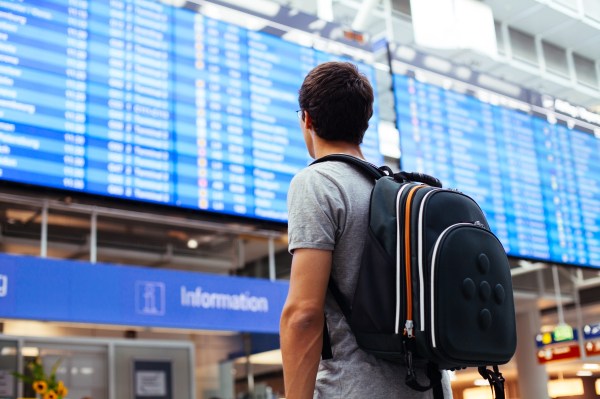
We’ll keep this lead-in short and sweet: You have to be doing pretty damn well before you stop caring about scoring cheap flights. For most of us, being able to shave a few hundred dollars off the price of a ticket is well worth the trouble. Besides, it’s not that much trouble, and there’s something inherently satisfying about gaming the system.
Read on and you’ll save money (while enjoying some superb stock photography). Thank us later.

"Hey, bro. It's me... just chillin' on the runway."
PART I. BEFORE YOU START LOOKING
- Know when to buy (in general). Kayak’s Travel Hacker Guide is helpful for letting you know how far out to start looking for certain tickets. From the U.S., Kayak recommends six months lead time for trips to Europe, while great Caribbean deals can be found as little as two weeks before your departure.
- Know when to buy (in specific). This subject is blurred by the haze of rumor and legend. We don’t need to venture too far down the rabbit hole, but in short: Due to how airlines schedule fare sales, you should do your shopping on Tuesday afternoon and early Wednesday morning. Fare Compare’s founder Rick Seany stakes his claim for Tuesday at 3 p.m., while travel expert Peter Greenberg pinpoints 1 a.m. on Wednesday as the time to catch the end of the weekly fare wars.
- Know when to travel (in general). The short answer is to travel in the off-season. Assuming you still want peak-season weather, travel in the shoulder season. Europe is beautiful in fall and spring and there are far fewer tourists, so locals will be more patient with your attempts to speak French. Rick Seany identifies travel “dead zones” right before or after a major travel spike (ex: two weeks before Thanksgiving or a few days after Jan. 1).
- Know when to travel (in specific). Sunday is an expensive day to travel; Tuesday through Thursday are typically good. Kayak’s Travel Hacker Guide is super helpful on this topic.

"My smile hides the long-term damage this is doing to my spinal column."
PART II. THE SEARCH IS ON
- Try the old “incognito mode trick.” At certain times in the history of the Internet, flight aggregators tried to squeeze customers by tracking cookies and bumping prices when users refreshed their browsers. There’s plenty of debate as to whether opening a browser in incognito mode helps anything, but because it doesn’t take any effort or time, it’s worth a try.
- Use a flight aggregator to find a baseline. You can often beat the aggregators, but they offer a good leaping-off place so that you have some idea of what you’re going to pay. Three good aggregators to start with are Skyscanner, Google ITA and Hipmunk. All of the aggregators have advantages and disadvantages that have been well-covered online.
- Check in on the budget airlines. Once you know your route and what the big airlines are doing, you can often save money by flying a leg of your flight on a budget carrier (particularly in Europe and SE Asia). Sites like WhichBudget will help you uncover the small companies whose routes mesh with yours.
- Visit sites directly. Once you’ve gotten to this point, visit the sites of the airlines directly in case there are front-page specials that connect to your dates.
- Know the hubs. This takes a little more time, but once you see which hubs have flights to your destination, you can basically break the flight down one leg at a time and search those legs on their own (mixing and matching different airlines). Adam Baker, founder of Man vs. Debt, gives a step-by-step tutorial of this process that’s easy to follow and replicate.
- Use Point-of-Sale to your advantage. Not only does it matter when you buy, but it also matters where you buy — as in, where you appear to be when you purchase your ticket. This not only helps for times when changing the point-of-sale is advantageous, it can also be used for those ultra-ambitious travel hackers who want to toy with exchange rates. For those desiring the simplest way to save, use the airline’s site or Google ITA to make you look like you are in the country where the flight originates. If you want to go deeper and play with currencies, follow Map Happy’s in-depth guide.
- Double-check within 24 hours. All U.S. flight purchases are cancelable, no questions asked, within 24-hours; it’s the law. So double-check your work after 22 hours or so, and make sure that you still got the best deal. If you didn’t, it’s easy to cancel and snatch up a better fare.
PART III. FLEXIBILITY ALWAYS WINS
- If you’re flexible with where to go: Flight predictors like Momondo can look at your dates and interests and let you know the cheapest places to visit. If your trip isn’t destination-specific, this is a good place to start.
- If you’re flexible with where and when to go: Adioso is endlessly fun to experiment with because you can broaden the parameters as wide as “travel anywhere in the world, any time” and get all sorts of ultra-cheap options.
- If you don’t need baggage: Uproxx covered the saga of Skiplagged and 22-year-old Aktarer Zaman; well, as of now, he’s still online after winning the first round of his battle against United (through a technicality). For now, Skiplagged allows you to buy “hidden city” flights that go past your final destination, allowing you to walk away during a layover and potentially saving you hundreds. A similar site called Fly Shortcut is taking a “break.” The link leads to an article about an Orbitz lawsuit and Zaman told CNN Money, “The cynic in me says this is in uphill battle.” So book these while you still can.
- If you’re able to fly an “open jaw”: If you’re traveling abroad and on the move, it makes sense to fly in and out of different airports — particularly if traveling over land is part of the fun of your trip and going back to the airport where you landed is going to burn time or feel redundant. Map Happy does an open-jaw tutorial, but you don’t need it. Google ITA makes it incredibly easy — all you have to do is separate airport codes with commas to find the cheapest fares in and out of multiple destinations.
- If you want to get a two-for-one by extending a stopover: Among vagabonders, Iceland Air is beloved for their free stopover policy. You can find fares with free (or low-cost) multi-day stopovers on Air France, Turkish Airlines, Japan Airlines and Finnair, too. Like Iceland Air, these pertain to stopovers in the country where the airline is based.
- If you’re ready to book the best deal you can find, right now: The algorithms that spit out fares aren’t always perfect — sometimes the system produces errors that the airlines will (historically) honor. The result is shockingly cheap flights (NYC to Johannesburg for $291 roundtrip, etc.). Secret Flying has a daily newsletter with error fares that usually expire within 24 hours — follow them on Facebook to make sure you don’t miss anything. The Flight Deal also comes up with some great error and open jaw fares that typically expire within a day or two. The mileage run discussion on Flyer Talk catches many of these first, while a recent Delta error was floating around Twitter for two hours before it was corrected.
- That last one bears repeating. And a photo. Secret Flying and sites like it will save you a ton of money if you’re ready to spontaneously buy a ticket.
**Have secrets we didn’t mention for how to save money on flights? Find something we got wrong?**
Share it in the comments.

"Where's my flight? I need to go stand on the runway."






